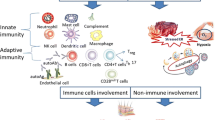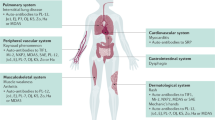Abstract
The idiopathic inflammatory myopathies, myositis, are characterized by a chronic course with decreased muscle endurance and by infiltrates of T lymphocytes and macrophages in muscle tissue. Treatment with immunosuppressives rarely leads to recovery of muscle function, despite abolishment of inflammatory cell infiltrates in muscle tissue. Therefore, other mechanisms than immunemediated muscle fiber damage are likely to contribute to the pathogenesis. One such non-immune-mediated muscle dysfunction could be caused by a disturbed microcirculation due to capillary loss or to phenotypically changed endothelial cells in the capillaries. These aberrations may affect the micro-environment of muscle tissue and lead to local tissue hypoxia with development of a secondary metabolic myopathy. Another possible non-immune-mediated mechanism leading to muscle dysfunction is the newly identified endoplasmatic reticulum (ER) stress response in myositis. The ER stress response is thought to be a consequence of the up-regulation of major histocompatibility complex class I in muscle fibers. These newly identified molecular pathways could play a major role in the pathogenesis of myositis and could be important targets in the development of new therapies.
Similar content being viewed by others
References and Recommended Reading
Love LA, Leff RL, Fraser DD, et al.: A new approach to the classification of idiopathic inflammatory myopathy: myositis-specific autoantibodies define useful homogeneous patient groups. Medicine (Baltimore) 1991, 70:360–374.
Brouwer R, Hengstman GJ, Vree Egberts W, et al.: Autoantibody profiles in the sera of European patients with myositis. Ann Rheum Dis 2001, 60:116–123. This study focused on autoantibody reactivity in a large cohort of European patients with myositis.
Miller FW, Waite KA, Biswas T, et al.: The role of an autoantigen, histidyl-tRNA synthetase, in the induction and maintenance of autoimmunity. Proc Natl Acad Sci U S A 1990, 87:9933–9937.
Arnett FC, Targoff IN, Mimori T, et al.: Interrelationship of major histocompatibility complex class II alleles and autoantibodies in four ethnic groups with various forms of myositis. Arthritis Rheum 1996, 39:1507–1518.
Casciola-Rosen L, Nagaraju K, Plotz P, et al.: Enhanced autoantigen expression in regenerating muscle cells in idiopathic inflammatory myopathy. J Exp Med 2005, 201:591–601. In this highly interesting paper the authors present support for tissue specific variations in autoantigen quantity. They also suggest a linkage between malignancies and dermatomyositis through the Mi-2 antigen which was highly expressed in tumor tissues.
Howard OM, Dong HF, Yang D, et al.: Histidyl-tRNA synthetase and asparaginyl-tRNA synthetase, autoantigens in myositis, activate chemokine receptors on T lymphocytes and immature dendritic cells. J Exp Med 2002, 196:781–791. In this study the authors present interesting evidence suggesting that autoantigens in myositis, such as the histidyl-tRNA synthetase, could function as chemokines. This observation suggests an important role of these autoantigens in disease mechanisms of myositis.
Arahata K, Engel AG: Monoclonal antibody analysis of mononuclear cells in myopathies. I: quantitation of subsets according to diagnosis and sites of accumulation and demonstration and counts of muscle fibers invaded by T cells. Ann Neurol 1984, 16:193–208.
Emslie-Smith AM, Arahata K, Engel AG: Major histocompatibility complex class I antigen expression, immunolocalization of interferon subtypes, and T cellmediated cytotoxicity in myopathies. Hum Pathol 1989, 20:224–231.
Page G, Chevrel G, Miossec P: Anatomic localization of immature and mature dendritic cell subsets in dermatomyositis and polymyositis: interaction with chemokines and Th1 cytokine-producing cells. Arthritis Rheum 2004, 50:199–208. This is a first paper to clearly demonstrate presence of dendritic cells, both immature and mature, in muscle tissue of polymyositis and dermatomyositis patients.
Greenberg SA, Pinkus JL, Pinkus GS, et al.: Interferonalpha/ beta-mediated innate immune mechanisms in dermatomyositis. Ann Neurol 2005, 57:664–678. In this paper the authors used microarray analysis in combination with immunohistochemistry on human muscle tissue to find support for a role of the IFN-α system in disease mechanisms in adult cases with dermatomyositis.
Haller O, Kochs G: Interferon-induced mx proteins: dynamin-like GTPases with antiviral activity. Traffic 2002, 3:710–717.
Girard JP, Springer TA: High endothelial venules (HEVs): specialized endothelium for lymphocyte migration. Immunol Today 1995, 16:449–457.
Englund P, Lindroos E, Nennesmo I, et al.: Skeletal muscle flbers express major histocompatibility complex class II antigens independently of inflammatory infiltrates in inflammatory myopathies. Am J Pathol 2001, 159:1263–1273.
Nyberg P, Wikman AL, Nennesmo I, et al.: Increased expression of interleukin 1alpha and MHC class I in muscle tissue of patients with chronic, inactive polymyositis and dermatomyositis. J Rheumatol 2000, 27:940–948.
Murata K, Dalakas MC: Expression of the costimulatory molecule BB-1, the ligands CTLA-4 and CD28, and their mRNA in inflammatory myopathies. Am J Pathol 1999, 155:453–460.
Murata KY, Sugie K, Takamure M, et al.: Expression of the costimulatory molecule BB-1 and its receptors in patients with scleroderma-polymyositis overlap syndrome. J Neurol Sci 2002, 205:65–70.
Behrens L, Kerschensteiner M, Misgeld T, et al.: Human muscle cells express a functional costimulatory molecule distinct from B7.1 (CD80) and B7.2 (CD86) in vitro and in inflammatory lesions. J Immunol 1998, 161:5943–5951.
Dalakas MC: Molecular immunology and genetics of inflammatory muscle diseases. Arch Neurol 1998, 55:1509–1512.
Lundberg I, Brengman JM, Engel AG: Analysis of cytokine expression in muscle in inflammatory myopathies, Duchenne dystrophy, and non-weak controls. J Neuroimmunol 1995, 63:9–16.
Lundberg I, Ulfgren AK, Nyberg P, et al.: Cytokine production in muscle tissue of patients with idiopathic inflammatory myopathies. Arthritis Rheum 1997, 40:865–874.
Sugiura T, Kawaguchi Y, Harigai M, et al.: Increased CD40 expression on muscle cells of polymyositis and dermatomyositis: role of CD40-CD40 ligand interaction in IL-6, IL-8, IL-15, and monocyte chemoattractant protein-1 production. J Immunol 2000, 164:6593–6600.
Schoser BG, Blottner D: Matrix metalloproteinases MMP-2, MMP-7 and MMP-9 in denervated human muscle. Neuroreport 1999, 10:2795–2797.
Schoser BG, Blottner D, Stuerenburg HJ: Matrix metalloproteinases in inflammatory myopathies: enhanced immunoreactivity near atrophic myofibers. Acta Neurol Scand 2002, 105:309–313.
Choi YC, Dalakas MC: Expression of matrix metalloproteinases in the muscle of patients with inflammatory myopathies. Neurology 2000, 54:65–71.
Kieseier BC, Schneider C, Clements JM, et al.: Expression of specific matrix metalloproteinases in inflammatory myopathies. Brain 2001, 124:341–351.
Wang J, Walsh K: Resistance to apoptosis conferred by Cdk inhibitors during myocyte differentiation. Science 1996, 273:359–361.
Sugiura T, Murakawa Y, Nagai A, et al.: Fas and Fas ligand interaction induces apoptosis in inflammatory myopathies: CD4+ T cells cause muscle cell injury directly in polymyositis. Arthritis Rheum 1999, 42:291–298.
Nagaraju K, Casciola-Rosen L, Rosen A, et al.: The inhibition of apoptosis in myositis and in normal muscle cells. J Immunol 2000, 164:5459–5465.
Li M, Dalakas MC: Expression of human IAP-like protein in skeletal muscle: a possible explanation for the rare incidence of muscle fiber apoptosis in T-cell mediated inflammatory myopathies. J Neuroimmunol 2000, 106:1–5.
Tews DS: Apoptosis and muscle fibre loss in neuromuscular disorders. Neuromuscul Disord 2002, 12:613–622.
Kissel JT, Mendell JR, Rammohan KW: Microvascular deposition of complement membrane attack complex in dermatomyositis. N Engl J Med 1986, 314:329–334.
Emslie-Smith AM, Engel AG: Microvascular changes in early and advanced dermatomyositis: a quantitative study. Ann Neurol 1990, 27:343–356.
Chung YL, Wassif WS, Bell JD, et al.: Urinary levels of creatine and other metabolites in the assessment of polymyositis and dermatomyositis. Rheumatology (Oxford) 2003, 42:298–303.
Ogawa S, Shreeniwas R, Butura C, et al.: Modulation of endothelial function by hypoxia: perturbation of barrier and anticoagulant function, and induction of a novel factor X activator. Adv Exp Med Biol 1990, 281:303–312.
Lundberg I, Kratz AK, Alexanderson H, et al.: Decreased expression of interleukin-1alpha, interleukin-1beta, and cell adhesion molecules in muscle tissue following corticosteroid treatment in patients with polymyositis and dermatomyositis. Arthritis Rheum 2000, 43:336–348.
Shreeniwas R, Koga S, Karakurum M, et al.: Hypoxia-mediated induction of endothelial cell interleukin-1 alpha. An autocrine mechanism promoting expression of leukocyte adhesion molecules on the vessel surface. J Clin Invest 1992, 90:2333–2339.
Salven P, Hattori K, Heissig B, et al.: Interleukin-1alpha promotes angiogenesis in vivo via VEGFR-2 pathway by inducing inflammatory cell VEGF synthesis and secretion. Faseb J 2002, 16:1471–1473.
El Awad B, Kreft B, Wolber EM, et al.: Hypoxia and interleukin-1beta stimulate vascular endothelial growth factor production in human proximal tubular cells. Kidney Int 2000, 58:43–50.
Falanga V, Qian SW, Danielpour D, et al.: Hypoxia upregulates the synthesis of TGF-beta 1 by human dermal.broblasts. J Invest Dermatol 1991, 97:634–637.
Niinikoski J, Paljarvi L, Laato M, et al.: Muscle hypoxia in myositis. J Neurol Neurosurg Psychiatry 1986, 49:1455.
Alexanderson H: Exercise: an important component of treatment in the idiopathic inflammatory myopathies. Curr Rheumatol Rep 2005, 7:115–124.
van der Pas J, Hengstman GJ, ter Laak HJ, et al.: Diagnostic value of MHC class I staining in idiopathic inflammatory myopathies. J Neurol Neurosurg Psychiatry 2004, 75:136–139. The authors tested the sensitivity and specificity of MHC class I expression on the sarcolemma in 224 muscle samples. They found a sensitivity of 78% and a specificity of 95% suggesting that this staining could be a valid test for diagnosis of inflammatory myopathies.
Civatte M, Schleinitz N, Krammer P, et al.: Class I MHC detection as a diagnostic tool in noninformative muscle biopsies of patients suffering from dermatomyositis [DM]. Neuropathol Appl Neurobiol 2003, 29:546–552.
Nagaraju K, Raben N, Merritt G, et al.: A variety of cytokines and immunologically relevant surface molecules are expressed by normal human skeletal muscle cells under proinflammatory stimuli. Clin Exp Immunol 1998, 113:407–414.
Nagaraju K, Raben N, Loeffier L, et al.: Conditional upregulation of MHC class I in skeletal muscle leads to self-sustaining autoimmune myositis and myositis-specific autoantibodies. Proc Natl Acad Sci U S A 2000, 97:9209–9214. The authors present an interesting animal model for myositis based on a genetically modulated mouse model with up-regulation of MHC class I in muscle fibers. This model suggests that up-regulation of MHC class I in skeletal muscle fibers by itself may cause muscle weakness before damage of muscle fibers occurs.
Nagaraju K, Casciola-Rosen L, Lundberg I, et al.: Activation of the endoplasmic reticulum stress response in autoimmune myositis: potential role in muscle fiber damage and dysfunction. Arthritis Rheum 2005, 52:1824–1835. In this report a new molecular pathway, independent of cell-mediated muscle fiber damage, was identified in both humans with dermatomyositis and in a transgene mouse model with MHC class I expression in muscle fibers. This could be an important contributing mechanism that could lead to muscle weakness in myositis patients.
Allison J, Campbell IL, Morahan G, et al.: Diabetes in transgenic mice resulting from over-expression of class I histocompatibility molecules in pancreatic beta cells. Nature 1988, 333:529–533.
Turnley AM, Morahan G, Okano H, et al.: Dysmyelination in transgenic mice resulting from expression of class I histocompatibility molecules in oligodendrocytes. Nature 1991, 353:566–569.
Reid MB, Lannergren J, Westerblad H: Respiratory and limb muscle weakness induced by tumor necrosis factoralpha: involvement of muscle myofilaments. Am J Respir Crit Care Med 2002, 166:479–484.
Ulfgren AK, Grundtman C, Borg K, et al.: Down-regulation of the aberrant expression of the inflammation mediator high mobility group box chromosomal protein 1 in muscle tissue of patients with polymyositis and dermatomyositis treated with corticosteroids. Arthritis Rheum 2004, 50:1586–1594. A very interesting new pro-inflammatory cytokine, high mobility group box (HMGB) 1, which is constitutively expressed in cell nuclei, was detected extracellularly in muscle tissue from myositis patients indicating a role in triggering the immune response in these disorders. Furthermore, it was still present extranuclearly in endothelial cells and muscle fibers after corticosteroid treatment, therefore this cytokine could be an important molecule contributing to chronicity of muscle inflammation.
Author information
Authors and Affiliations
Corresponding author
Rights and permissions
About this article
Cite this article
Grundtman, C., Lundberg, I.E. Pathogenesis of idiopathic inflammatory myopathies. Curr Rheumatol Rep 8, 188–195 (2006). https://doi.org/10.1007/s11926-996-0024-4
Issue Date:
DOI: https://doi.org/10.1007/s11926-996-0024-4




